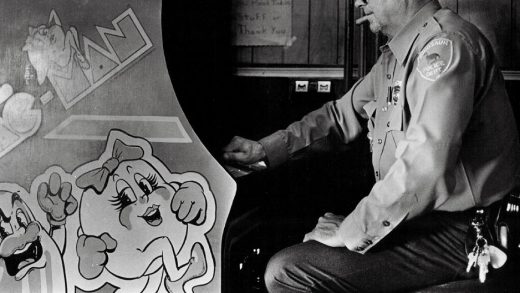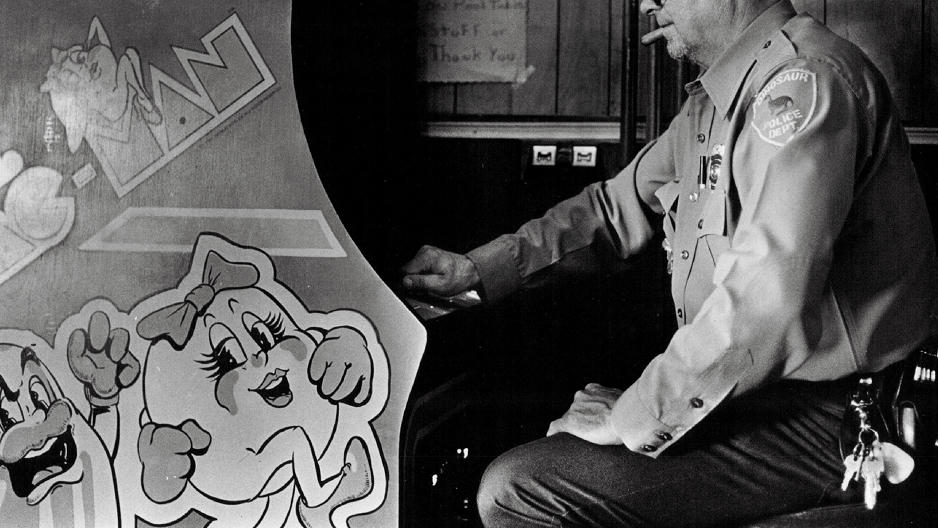The MIT Dropouts Who Created Ms. Pac-Man: A 35th-Anniversary Oral History
Thirty-five years after its release, Ms. Pac-Man is one of the most successful and enduring video games of all time. After debuting publicly on February 3, 1982, in its original form as an arcade game from Bally Midway, versions have since appeared on at least 28 different game and computer platforms.
Today, this “first lady of video games”—as she was dubbed by Midway in 1982—remains a ubiquitous ambassador of coin-op games, as the machine can still be found in restaurants, truck stops, arcades, and other venues across the U.S. In fact, having sold 117,000 units in this country (more if you count recent re-releases combined with other games), Ms. Pac-Man still holds the all-time sales record for a standalone arcade video game in the U.S. (Her spouse, Pac-Man, holds the No. 2 spot.)
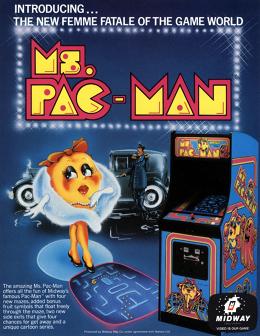
Despite its dramatic success, few people know that this arcade classic was not developed by Japanese firm Namco, the company behind Pac-Man. In fact, a small group of MIT dropouts from New England created the game. In an astounding feat of business acumen and teamwork, they sold Midway on the concept and quickly pushed the game into record-breaking reality.
In 2011, I conducted extensive interviews with three of Ms. Pac-Man’s creators for a planned feature about Ms. Pac-Man’s creation for the game’s then upcoming 30th anniversary. While the subject has since been covered in other venues, I have found that my original interviews are still packed with nuggets of information that have not yet come to light.
For this oral history, the participants’ responses have been edited for length and clarity and arranged to tell the story. Set in New England rather than the familiar setting of Silicon Valley or Japan, their tale is one of creativity, gumption, and loyalty among a group of gifted friends who happened to work very well together.
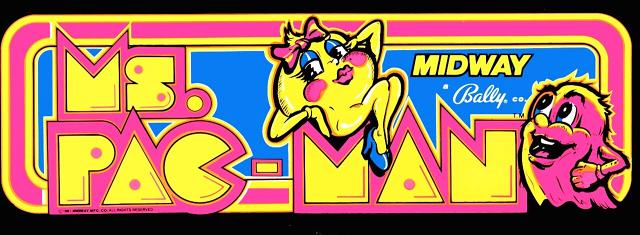
Meeting Up And Dropping Out At MIT
At the time of Ms. Pac-Man’s release in early 1982, arcade mania was in full swing in the U.S. Concepts pioneered in coin-op games filtered down to console and home computer level, and advertisements for less-advanced home titles bragged of “arcade-like realism,” as if it were the peak aspiration of all games.
Such was the primacy of the coin-op realm in video game culture when a group of young students at Massachusetts Institute of Technology (MIT) in Cambridge first began dabbling in the arcade business as a side job in the late 1970s.
Steve Golson, former engineer, General Computer Corporation: I moved into a dorm at MIT in ’76 as a freshman, and the following year Doug Macrae and Kevin Curran moved in as freshmen into the same double suite of rooms that I lived in. That’s how we all met each other.
Doug Macrae, cofounder and former chairman, General Computer Corporation: In 1977, I went up to start MIT. I was working on a combined bachelor’s and master’s degree in mechanical engineering, economics, and architecture. My thesis was supposed to be done in the spring of 1981, and I never got around to it. Rather than doing my thesis, I developed Ms. Pac-Man.
Golson: In our dorm, there was a local guy who had pinball games. His games kept getting trashed, and he finally pulled his games out. Doug’s brother had this old Gottlieb Pioneer game and we had a big party coming up, and we said, ‘Hey, we don’t have a pinball game.’ Doug said, ‘Well, I can get my brother’s game.’
Doug was working on the game one day and Kevin was there and they said, ‘Hey, we could start a business doing this.’
Macrae: Kevin Curran and I operated the original video game route on campus.
Golson: They joined up and bought a new pinball game and put it in the dorm, and that was really successful. They got another one and put it in the dorm. I got involved really early on helping them out with running their games at the dormitory.
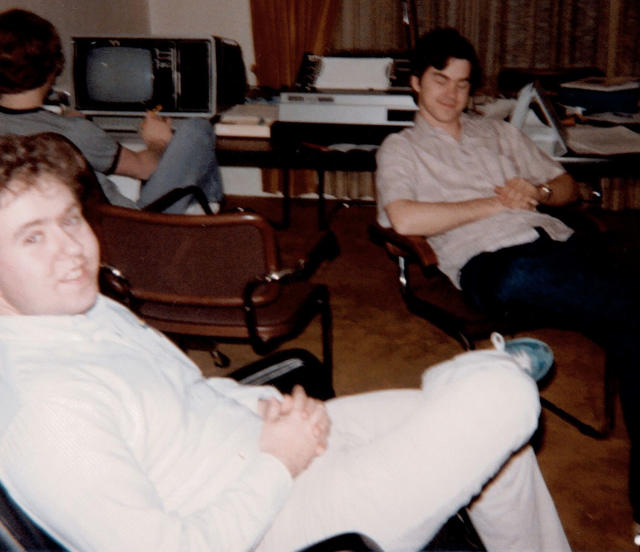
Macrae and Curran’s arcade route—a series of machines they owned and operated both for their own profit and for the benefit of students—quickly expanded to three dorms, but they soon had trouble with declining revenues as people began to master the games. As arcade operators themselves, they had a direct financial stake in making the games more interesting. So they did what any clever MIT student would do in that situation: confront the problem with mathematical precision. And their thinking gravitated to Atari’s Missile Command, one of the most popular games of the early 1980s.
Macrae: When we first got them, our Missile Command games on the MIT campus were pulling in roughly $600 a week. If you do the math on that, that’s one quarter every three minutes on 17 hours a day. The problem became if a game lasted longer than three minutes, the quarter count would go down, or if it wasn’t being played 17 hours a day because people didn’t like it as much, and were not standing in line to play it, the quarters went down.
We were looking at ways to keep the time-per-game down some—because it was obviously creeping up as people got good at it—but also to keep the excitement there so people would want to play it more often. We were trying to keep the quarter count up in any way we could.
Golson: At this point in the video game world there were these kits called speed-up kits or enhancement kits that were being sold directly to arcade owners. The first really successful one was for Asteroids because people learned how to beat Asteroids, and they could play forever on a quarter. So somebody game up with a little circuit that you could clip on, and wow, it made the game much more difficult.
Doug and Kevin started looking around for an enhancement kit for Missile Command, but nobody had figured out how to do it. The complexity of the programming techniques of the game were substantially more difficult than the other games. You had to understand how it was programmed. Doug and Kevin said, ‘Well, hey, we go to MIT. I bet we can figure it out.’
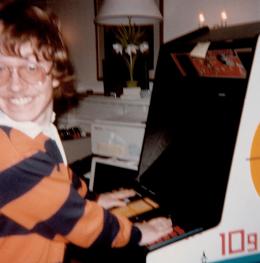
Macrae: We did the enhancement kit to Missile Command, called Super Missile Attack, and were wildly successful with it—at least for college kids. We sold 1,000 kits at roughly $250 profit per kit, and made a quarter of a million dollars while in college. Super Missile Attack was designed to make the game more interesting, more challenging, and take away some of the shortcomings of the game.
When taking inflation into account, $250,000 in 1981 is roughly equivalent to $663,000 today. Macrae and Curran met their newfound success by incorporating the business into a firm called General Computer Corporation (GCC). Lacking the capital to pay engineering salaries, they set up a profit-sharing structure to benefit those who worked for the small firm.
Macrae: Kevin and I were the two founders of the company and owners of it. John Tylko was brought on primarily as a business partner; he did not do any of the programming. The other three, Mike Horowitz, Chris Rode, and Steve Golson, were engineers. Kevin and I were equal partners, and the other four were set up to share in the profits.
Golson: I was there in the spring of ’81 when they decided to start up this company. Doug and Kevin had moved off campus and with a couple of other students. They were renting a house in Brookline. They said, ‘Oh, we’ve got a spare bedroom in this house. You could live with us.’
Macrae: Technically I think I was chairman and Kevin was president. I’m not sure whether we had established it formally. It might have just been on the legal filing in Massachusetts.
Enter Pac-Man
As Super Missile Attack proved popular, it became evident to Macrae and Curran that they could expand their arcade enhancement kit business. They experimented with modifying Atari’s hit game Asteroids and other titles, but one breakthrough maze game from Japan caught their attention in particular.
Namco’s Pac-Man had been released in the U.S. in the fall of 1980 by Bally Midway, but it wasn’t until early 1981 that it began to make waves in the U.S. arcade market. With its iconic characters and easy-to-learn game play, Pac-Man soon became a cultural force unto itself that moved beyond video games and into merchandising, music, and, eventually TV.
Macrae: After the success of Missile Attack, we looked up and said, ‘We should do this again,’ and the most successful game at that time was Pac-Man, and we said, ‘Let’s do an enhancement kit for Pac-Man.’
Golson: Pac-Man had already been a big hit in Japan and the Far East, and we knew it was going to be a big thing.
Macrae: We had a Pac-Man cabinet and we played it over and over again, trying to say, “What are its weaknesses? Why are we bored? Why would be able to play for a long amount of time?’
We realized that Pac-Man had the same kind of issues Missile Command did. People could learn the patterns and play it forever, and that once you played it for a while, it was pretty much the same game. It got a little bit faster, but there was only one maze, and nothing really changed.
Golson: We wanted to have more than one maze instead of the same maze every time. We wanted to make the character algorithm truly random so that it was no longer predictable and make it harder. Those were really the big things that drove us.
Macrae: We attacked it in the same way as Missile Command—in trying to take what was good in Pac-Man and make it even better. That’s what became Crazy Otto.

GCC hoped to avoid trademark issues by reworking Pac-Man’s characters and visuals into something similar but not identical.
Golson: We brought a woman named Patty Goodson, who was a professional musician, on board to come up with game ideas for us. I remember her drawing the character of Crazy Otto. I’m not sure if that was after we had picked the name and knew what he looked like, or if she came up with the name.
We started Crazy Otto in late May or early June of ’81, pretty much right after the Super Missile Attack was done. For Crazy Otto, we gave him legs and blue eyes inspired by the side of the Pac-Man cabinet.
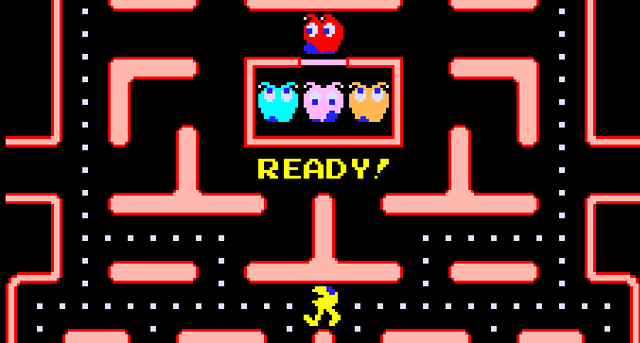
During the development of an enhancement kit for Pac-Man, most of the GCC crew moved into a five-bedroom house in Wayland, Massachusetts. At first, Doug Macrae, Kevin Curran, Steve Golson, Chris Rode, John Tylko, and a friend named Larry Dennison all lived in the house at the same time. They soon brought on two more engineers to help with the project: Mike Horowitz and Phil Kaaret. While Macrae got married and moved out shortly thereafter, the house still served as the locus for the company’s development activity.
Mike Horowitz, former software engineer, General Computer Corporation: They were all MIT guys, and they all knew each other, and they were all living in this house.
Macrae: Mike Horowitz was an engineer out of Cornell. I had worked at the same company as he did, Computervision, and I recruited him.
Golson: The house belonged to a professor who was taking a sabbatical and sailing a sailboat to Norway.

Horowitz: Doug and I did not live there, and we were both newly married. We were both competitive people, so we’d see who could get there earlier. You would come in the door, and to the right was a kitchen area. To the left was this, I guess you’d call it a sun room. It was a big room, and that’s where we had all our emulators set up.
Macrae: We were using in-circuit emulators created by Tektronix, which were roughly $25,000 computers that could emulate Pac-Man’s microprocessor.
Golson: We had a desk right next to the front door which is where our secretary, Cathy Rohrs, would sit. UPS would come by every day to pick up our shipments.
Macrae: Down in the basement we were doing the manufacturing of the Super Missile Attack board—stuffing them, putting them in packages—and we were taking phone calls anywhere it rang in the house to take orders.
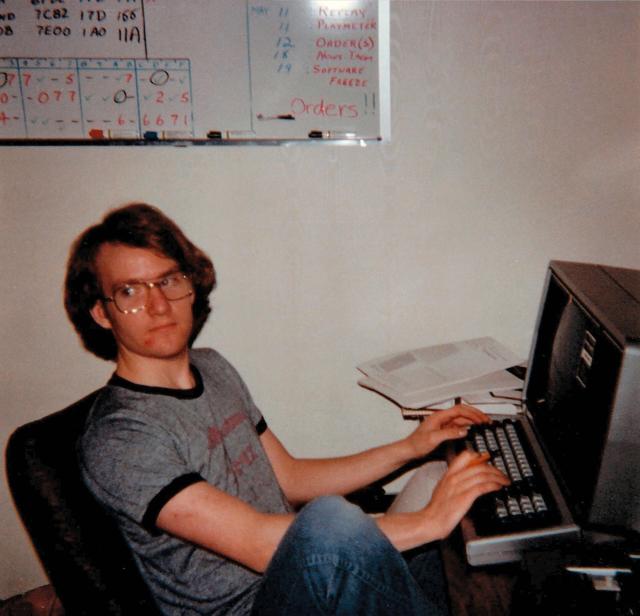
Horowitz: I would just come in, park myself at my emulator, and start coding. That was at like 7 or 8 a.m. The other guys, they’d come down at like 10 or 11 in their pajamas, go have breakfast, then see how I was doing.
Golson: I remember times where I’d come downstairs in my bathrobe, but that’s what we did. Basically, we were just working nonstop. Doug was married, but he was there pretty much all the time.
Like Pac-Man, Only Better
Living and working in close but comfortable quarters in the relative isolation of a house up a wooded hill in Wayland, the young crew set out to implement its planned improvements to Pac-Man.
Macrae: The maze design was being done carefully to help prevent areas where you could get dead spots and hide from the monsters. It took a good bit of time to create interesting ones that would be challenging for people and not have the monsters get trapped or stuck. They were originally designed on graph paper, then implemented and tried out. We kept playing with them until we liked them.
Horowitz: I, unlike everyone else at GCC, actually graduated from college in 1979. Doug said he’d be able to pay me no salary, but my wife made enough to support us.
By the time I joined, they had already made the mazes. I had to come up to speed. I knew nothing about microprocessors, or video, or anything. I had been doing CAD/CAM software.
The first thing I did was work on sounds. We had to reverse-engineer the game. Reverse-engineering the sound generator was pretty much impossible, but I just played around, substituting in values trying to get a feel for what changed if I put a 6E here instead of a 24. I did all the sound effects for the whole game. Chris Rode did the music.
Golson: I remember Chris on the piano there at the house figuring out the music for the attract mode and for all of the intermissions for all the cartoons.
Horowitz: Then I did the intermission animations. I remember driving to a friend’s wedding. It was a long drive, and I’m in the car with my wife, and just thinking. That’s where I thought of the three animations. It was basically boy meets girl, and they chase each other, and then they find true love.
Macrae: As we strived to look for more interesting improvements, at some point it was mentioned that we could have the fruit move.
Golson: We had the idea to move the fruits around the maze because the hardware allows you to have six moving objects. There’s the four monsters, then Pac-Man, and then the bonus fruit. In Pac-Man, they never moved the fruit around. We said, “Well, if the hardware allows us to move it around, why don’t we move it around?’
Macrae: Once we started the fruit moving, it became really fun to try to catch it.
Golson: With the fruit design, the thought was, again, we were trying to be careful to not infringe on the other guys’ trademarks, and if they had a particular character that was recognizable like Pac-Man and the monsters and the Galaxian ship, well, we’re not going to use that. So that’s what we changed.
The two cherries is not trademarked because everybody uses that same two cherries image on every slot machine game. That’s where the fruits came from. The pretzel bonus fruit was because Kevin Curran really loved pretzels.
With its new mazes and its refined monster AI, Crazy Otto aimed to overcome the patterns that Pac-Man players memorized to play the game perfectly on a single quarter. That would give Crazy Otto the potential for gameplay longevity that Pac-Man never had.
Horowitz: The original Pac-Man was totally deterministic. It played the same way every single time. You could hide in a spot, walk away from the game, and the game would play forever, because the monsters would never get you.
We added some randomness to it, and we made the monsters have different modes depending on the level of the game the different amounts of time at each mode. They would either chase Ms. Pac-Man, they would run away from Ms. Pac-Man, they would go to some specific corner of the maze, or they would just take a bunch of left turns. When they went to their corner we made them go to a random corner instead of going at the same corner every time. Just doing that made it different every time.
Tangling With Atari
Not long after the release of Super Missile Attack—and during the development of Crazy Otto—Atari caught wind of the unauthorized Missile Command add-on board and planned to sue GCC to stop its distribution. GCC heard of Atari’s plans through a local arcade distributor, and in July 1981, the startup preempted Atari with a suit of its own, ensuring that GCC could pick the venue, which meant that the trial would take place in Massachusetts and not California. That gave the small firm a considerable home field advantage in the negotiations that commenced after Atari, then a division of media giant Warner Communications, sued GCC for $15 million.
Horowitz: I joined, and pretty much a couple weeks after, Atari filed the restraining order against GCC to stop them from selling Super Missile Attack.
Golson: At that point, Atari was like Google plus Microsoft. They were the high-tech behemoth that could do no wrong and were doing amazing stuff.
I think they felt that we would just be so cowed by, ‘Oh my gosh, Atari is suing us.’ I’m sure that was successful with other people. These people doing the rip-off clones of games, you send them a nasty letter and you say, ‘Please stop making Asteroids T-shirts because that’s our trademark.’ People would say, ‘Oh, of course. We’ll do whatever you say.’
Instead, we said, ‘Yeah, okay, bring it on. Let’s go to court.’ We felt like we must really be something if we’ve gotten Atari’s attention.
We had nothing to lose, and we actually had carefully thought about what they were claiming, which was that we had infringed their copyright and trademark and unfair trade practices. We had previously thought about how to design our kit as such that we do not violate their copyright and trademark. It wasn’t like we had just gone into this planning on infringing or knowing that we infringed.
Horowitz: We could have burned ROMS that were the game plus our changes. But we didn’t want to do that, because there was the whole legal issue of copyright, so we didn’t want to copy their code. What we produced was all our code, we wrote it all, and we were just adding it to the game, sort of an aftermarket thing.
Golson: We had this little daughter board that we would sell to the arcade owner and they would unplug their ROMs and plug them into our board, and then our board would plug into their Missile Command game. For business reasons and also for legal reasons, that’s how we built it. We felt pretty confident that we would eventually prevail if we had gone to court.
Atari succeeded in getting a temporary restraining order to keep Super Missile Attack off the market until the suit could go to trial, although the judge gave GCC an opportunity to address Atari’s complaints and resubmit a new version of the game that they could potentially sell in its place.
GCC’s maneuvering and moxie caught Atari off-guard, and the suit soon became an annoyance for Atari’s executives, whom were suddenly and unexpectedly under threat of being deposed to appear across the country in Massachusetts court. The suit also presented a David versus Goliath PR problem as the case gained press attention, and Atari soon sought a way to make it end quickly.
Macrae: We fought in court for a while, and eventually Atari came to us and said, ‘What do you guys really want out of this?’ They definitely did not want enhancement kits done. We said, ‘What we’re really after is designing games.’
So as a way of buying us off, they gave us a development contract saying, ‘Here’s $50,000 a month for the next two years, or $1.2 million, and in exchange, develop games for us with no strings attached.’ We didn’t really have to do anything.
We later found out that Atari just wanted us to go sit on the beach, or go back to school, and never wanted to see us again. What we did was eventually started developing video games for them.
Golson: It was go-away money, but we said, ‘No, we’re going to design games for you.’ We took the money and started cranking out games.
Getting Midway’s Attention
The settlement of the Atari-GCC suit on October 8, 1981, marked a new beginning for the small New England company, which would go on to design several arcade games and an entire new home console (the 7800) for Atari over the next several years. But the most immediately pressing issue was the fate of Crazy Otto, whose development had been ongoing during the tussles with Atari in court.
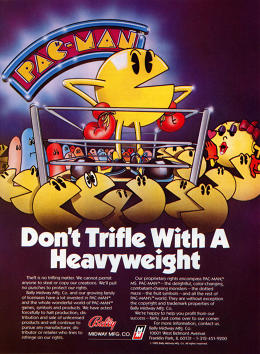
Golson: As part of the negotiations with Atari, Kevin and Doug said, ‘Hey, we’ve been working all summer on this kit for Pac-Man. We’d like to be able to sell it, and that’s totally independent of whatever deal we do with Atari.’
Atari said,’Okay, We will allow you to sell enhancement kits as long as you can get the manufacturer’s permission.’
Macrae: Atari did not want [unauthorized] enhancement kits out there in the industry because it would set a precedent that they did not want happening.
Golson: So Kevin calls up the president of Midway, a guy by the name of Dave Marofske—just cold calls him. One president to another. Kevin’s an MIT dropout, but says, ‘Dave, maybe you saw in the news that Atari dropped their lawsuit against us, and we’re about to bring out a kit for your game Pac-Man.’
Macrae: We told him we were going to produce the enhancement kit with or without them. We’d just like to get their blessing, rather than ending up in court with them.
Golson: Marofske is in court all the time against people making unauthorized Pac-Man merchandise, so to have somebody who actually calls him up and talks to him, he thought that was pretty cool.
Marofske says, ‘Hey, are you going to be in Chicago? Why don’t you show us what you’re working on?’
Macrae: We happened to show up shortly after their production had ended on Pac-Man. They’d run 24/7 for months, and had nothing in the pipeline. They were about to lay off lots of people, and we walked in with what they saw as the sequel to Pac-Man.
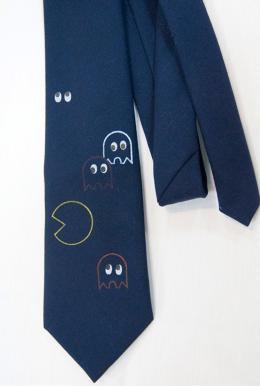
Golson: I flew in with the prototype kit. Kevin, Doug, and I go off to see the folks at Midway, including Marofske and Stan Jarocki, who was the head of marketing. They brought in one of their assembly guys, who was really good at playing Pac-Man, to play it. He plays the game for a little while, and he likes it.
They said, ‘Thanks very much’ and they gave each of us a Pac-Man tie. We packed up and flew home.
Macrae: Midway was very impressed with Crazy Otto. The game played very well. We’d already had it out on test in Framingham, Massachusetts, and it was earning very well.
Golson: Over the next week or so we’re having these negotiations with them about what kind of a deal would we have.
Macrae: Midway said, ‘Let’s not do it as an enhancement kit, let’s create the sequel to Pac-Man.’
Golson: I went back out about a week later with a more complete kit that they then put on location in Chicago to test to see how well it would work in an arcade. That’s mid-October.
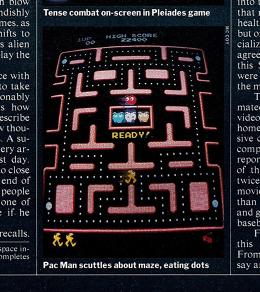
Macrae: While it was out there, a photographer for TIME magazine was sent on an assignment to write about video games, and he wanted to go get a picture of Pac-Man. He walked into one of the only arcades in world to have a Crazy Otto. He took a picture of it, and used it as his picture of Pac-Man.
Golson: The test on location went really well. On October 29, we signed the agreement with them for Crazy Otto. It was a royalty thing, so we got a certain amount if they sold it as a kit, and we got more if they sold it as a complete game. So now we’re frantic in getting it done so they can go into production.
Horowitz: The fact Doug and Kevin knew that there was only one way they could sell this thing, and how they convinced Midway to do it, is just one of the great sell jobs. They were kids. They were like 21 years old. They had some stones, you know?
Becoming Ms. Pac-Man
After signing a contract with Bally Midway on October 29, 1981, for Crazy Otto, GCC began the process of modifying their once-illicit aftermarket mod into a full-fledged sequel to Pac-Man. With guidance from Midway and some input from Namco, Crazy Otto began to take a new thematic direction.
Macrae: As soon as Midway said, ‘Let’s make a sequel out of it,’ we no longer had to avoid the Pac-Man name. They originally said, ‘Let’s make it into Super Pac-Man.’ I think that was the first game that they suggested.
We looked at the intermissions. Even on Crazy Otto, in the first intermission, a yellow Pac character with legs called Otto meets a red Pac character with legs, which obviously had to be a female Otto, because a heart goes above their head. They chase each other, and eventually a baby is brought to them by the stork.
We were looking and going, ‘Wow, we’ve got a whole storyline here about how a character meets a red character that’s female. Why don’t we turn this into a male and female Pac character, and build a bit more personality into them?’
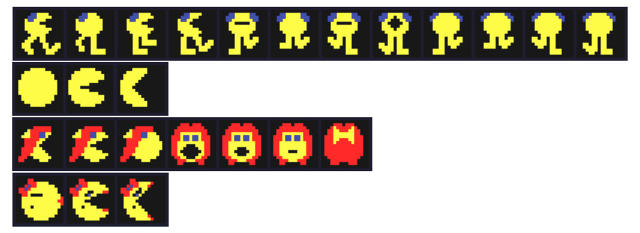
Golson: In the span of just two weeks, it went from Crazy Otto to Super Pac-Man to Miss Pac-Man, which is what it says on this little board that they manufactured. It was Pac-Woman at some point. Then again very quickly it changed to Ms. Pac-Man.
Macrae: “Pac-Woman” did not roll off the tongue very well. It then became “Miss Pac-Man,” and it was that way until someone pointed out that the third intermission had Mr. and Miss Pac-Man having a baby brought to them. We need to have them married.
Word was sent back to Mike Horowitz that it should be Mrs. Pac-Man. Well, Mike was married to Eileen Mullarkey who refused to take his last name. She really did not like going by the name Mrs. Horowitz, or even Mrs. Mullarkey. She liked Ms. Mullarkey.
Horowitz: The women’s movement was kind of big then—Ms. magazine—so Ms. was the new thing. I married in ’81, and my wife didn’t take my last name. She said that if I changed my name to her name, she would change it to something different just because she didn’t want to have the same.
Horowitz: My wife just thought, you know, she’s an independent woman—she can be. In the progression of the animations, the implicit thing is they do get married, because they have a child. But she’s still a Ms.
During the one or two weeks when potential names for the new female Pac-character were being debated, Mike Horowitz began working on new artwork for the game to bring everything in line with the new concept.
Macrae: Mike Horowitz designed the Ms. Pac-Man character, with some review cycle going on with both Bally Midway, and with Namco in Japan. The first character we had was a Ms. Pac-Man with red hair—shoulder-length red hair, not that she had any shoulders.
Horowitz: It was hard to develop the characters. I used graph paper and colored pens, and would draw them, and then you’d have a 16-by-16 three color picture, and then you’d have to hand code them into a ROM burner, and it wasn’t straightforward.
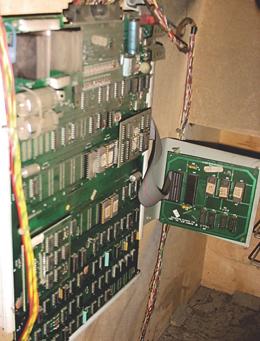
Macrae: We sent out ROMs to Midway, and they sent them over to Japan for the President of Namco, Masaya Nakamura, to look at. He said, “Love the concept, get rid of the hair.” Ms. Pac-Man lost her hair—it was actually Pac-Woman at the time, I believe. The beauty mark stayed, and the lips stayed. I think we added a bow, and were quickly done with it, so Ms. Pac-Man had been created.
Masaya Nakamura died on January 22, 2017.
Golson: As I recall, the Midway folks had some suggestions. ‘Hey, let’s have a bow, let’s have eyelashes and a beauty mark.’ Well gosh, it’s only 16-by-16 pixels. We went through several iterations. We tried several different things until we ended up with what we’ve got.
Macrae: We used a Lite Brite on Ms. Pac-Man some also, as a way to see what some of the characters would look like. It provided a relatively inexpensive character development system. Mike Horowitz insisted on doing it by hand on graph paper.
Courting Namco
Considering the unusual nature of how Ms. Pac-Man came to be, there has been much confusion over the years in history books and press reports about who gets credit for what in the game, and if Namco ever actually gave Midway approval to create Ms. Pac-Man, even thought Midway possessed the legal latitude through its Pac-Man license with Namco to do so. Today, Doug Macrae and other GCC veterans take special care to note that Namco was aware of Ms. Pac-Man during its development.
Macrae: Basically, Namco was fully approving of Ms. Pac-Man. In fact, their president was approving what the character would even look like. At the same time, there was a little bit of embarrassment, I believe, in-house in Japan, of the fact that the sequel was being done somewhere other than in their own laboratories.
There was always a little bit of bad feeling there, but they were fully aware. The arrangement that Namco had with Midway was that Namco would still get their royalty on Ms. Pac-Man, being the same as what they got on Pac-Man, and Midway could choose to do whatever they wanted in paying us a royalty in addition to Namco.
Because of its design, Ms. Pac-Man still operated as an after-market add-on board—even during its production run. So Midway essentially sold a copy of Pac-Man every time they sold a copy of Ms. Pac-Man. In that way, Namco still got the same Pac-Man royalty on every unit of Ms. Pac-Man that sold.
Horowitz: If you open up a Ms. Pac-Man, it’ll have a Pac-Man board in it with our data card that sits in the processing slot. When the Pac-Man program came to certain addresses, it would jump to run the software in our data card.
Macrae: Every Ms. Pac-Man ever made has a Pac-Man board in it and a Ms. Pac-Man add-on, the same way Super Missile Attack was an add-on. If you were to remove that board, you’d get Pac-Man. Our intention was, once we went into production, that it would eventually be integrated onto one board, but things moved so fast that the entire [standalone] production run of Ms. Pac-Man was done with Pac-Man boards and Ms. Pac-Man enhancement kits.
The graphical appearance of Ms. Pac-Man wasn’t the only suggestion that Midway offered the development team at GCC. During the final, frantic push to finish the game, GCC went back and forth repeatedly over minor changes, and some last-minute bugs were fixed. But the team still likes to stress that Ms. Pac-Man was their creation.
Golson: The only difference between the Crazy Otto that we showed Midway and Ms. Pac-Man was the characters. The Crazy Otto characters and monsters were gone, and it was back to the old original monsters and the new Ms. Pac-Man female character. Nothing else—other than a couple of minor bug fixes, which made no difference to the appearance. The music, the colors, the mazes, the game play, everything—none of that came from Midway.
Macrae: The fourth monster in Ms. Pac-Man is named Sue, which is my sister. I always get to joke about that with her a little bit. I worked really hard to make sure I could name a monster after my sister. It was a great way to take an inside poke at her.
Horowitz: Toward the end, I found a spot where Ms. Pac-Man could hide. We didn’t want to ship like that, so the one last thing I did was with the red monster. When the red monster was put in chase mode, it went directly at Ms. Pac-Man and never left chase mode. That way if you ever found a corner where you could have hidden, once the red guy starts chasing they’ll chase forever, and then, well, get you.
Golson: Midway kept coming back with what to us were silly changes. They could not make up their mind what the copyright was going to say. Make it do this. Okay, we’d turn it out. Then it would be, ‘No, no, make it do this.’ There was some of that towards that December/January timeframe. We just wanted to be done with it.
Horowitz: We gave Midway the board and the software, and they did everything else.
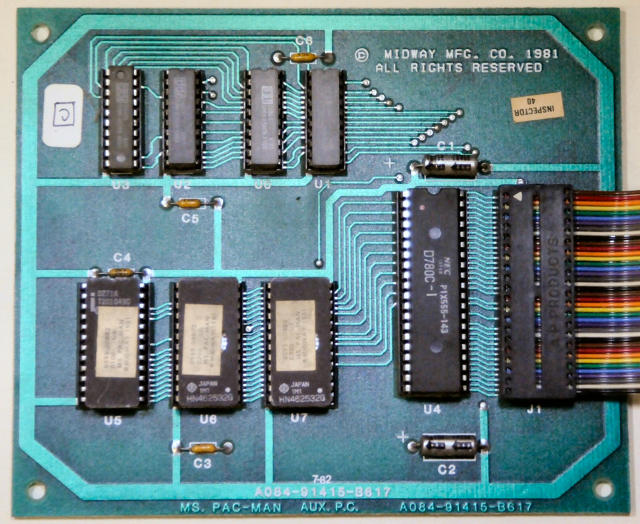
Success!
Ms. Pac-Man made its worldwide public debut on February 3, 1982, during a press conference held by Namco at Castle Park Entertainment Center in Sherman Oaks, a neighborhood of Los Angeles. Local reports of the conference spread nationwide through wire services, and word of Pac-Man’s new female counterpart, complete with cheeky headlines (“Why is Pac-Man Grinning? Because He’s Sharing His Quarters.”) ran widely in papers across the U.S. By every measure, the response from both the press and video game players was immediately enthusiastic.
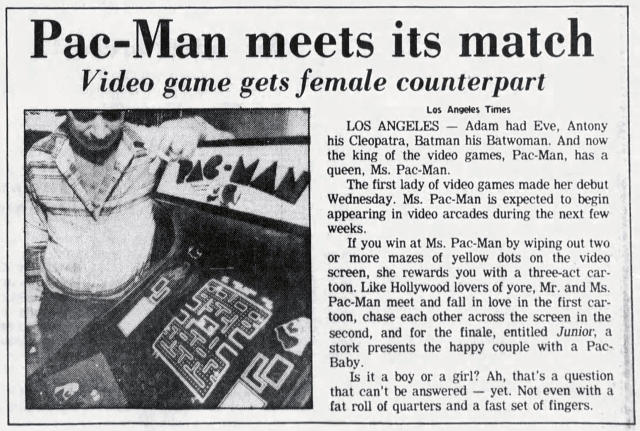
Horowitz: There was an old arcade between Central Square and Harvard Square in Cambridge called 1001 Plays, and we found out that they had a Ms. Pac-Man, so we all rushed over, because it wasn’t far from where we were. It was just so cool to go into an arcade and see this thing that you had done. It was awesome.
It was the first time we ever saw the cabinet. We didn’t know what the artwork would be. When we got there, there were people playing it, and I think it was a hit from day one.
Golson: It got rave reviews. All the changes we made from Pac-Man to Ms. Pac-Man were just universally accepted and people said, ‘Pac-Man was great, this is even better.’ That, again, was a real vindication the improvements we had made were well thought-out.
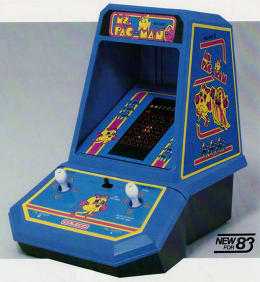
Macrae: Midway kept the Ms. Pac-Man production line running as long as orders kept coming in, 24/7. They produced 117,000 units. General Computer made roughly $10 million on the Ms. Pac-Man arcade at the time.
Golson: That year while it was such a huge, big thing, it was this feeling of being on top of the world. Here we are, dropouts in our newly rented space and we got this development deal with Atari, the biggest consumer electronics company in the world, and we had the No. 1 video arcade game. It was just a wow, we’re just doing well on everything.
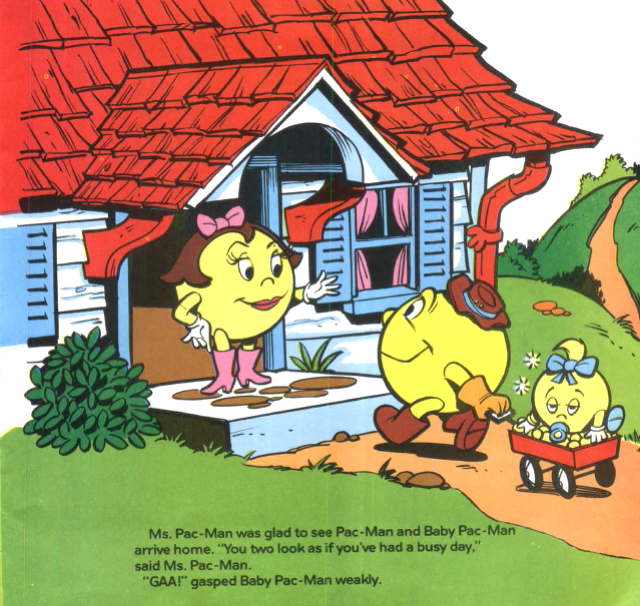
Interestingly, one of the reasons for Ms. Pac-Man’s astronomical sales success in the arcade may have been a clever copy protection method baked into its hardware design that strongly deterred clones from flooding the market and cannibalizing its sales.
Steve Golson: There was a chip called a PAL, which stood for Programmable Array Logic. You could program your own digital logic into it, and then you could prevent it from being read back out, so you could not tell how it had been programmed.
The Ms. Pac-Man had four of these PALs, and the sophistication of the security technique was quite a bit more than the Super Missile Attack. It really prevented it from being copied because there were certainly people who tried.
As Ms. Pac-Man became wildly popular, GCC stayed busy with their Atari contract. They blazed through dozens of games at the twilight of the golden age of the American video game industry—a period that included the major video game market crash that hit in 1983-84.

Macrae: The success all happened unbelievably quickly, that not only did Ms. Pac-Man get put into production, and 117,000 made very, very quickly, but at the same time we were diving into designing games for Atari, and those were also taking off. Not in the same quantity in the arcade, but we were doing very well in the home market.
In addition to Ms. Pac-Man, during the next few years, we shipped 76 other games, mainly for Atari’s 2600, 5200, and eventually the 7800, which we designed, and got paid on each one of those.
Horowitz: The whole game era was kind of short-lived. In four years, it was pretty much all over. Atari got sold, and we lost our funding, and we started doing other things. It was just like a little kind of blip.
Macrae: I don’t think it was until 1984, 1985, that we kind of came up for breath, when the market slowed down, and we had a chance to look around.
The Fight For Ms. Pac-Man
Like Pac-Man before it, Ms. Pac-Man became a blockbuster overnight, spawning reams of merchandise like T-shirts, comic books, lunchboxes, toothbrushes, bed sheets, pajamas, board games, puzzles, trash cans, and more. Before long, GCC even created a follow-up arcade title for Midway called Jr. Pac-Man.
With GCC busy at work with new projects, Midway went full throttle in pursuing Ms. Pac-Man licensing opportunities—to the exclusion of GCC. In September 1982, a Saturday morning cartoon from Hanna-Barbara debuted and got the small firm’s attention. It featured the basic family plotline introduced by GCC during Ms. Pac-Man’s animated intermission scenes (and the ghost named Sue), and GCC felt it had to speak up to avoid being excluded from profiting on its own creation.
Macrae: Who owns the rights to Ms. Pac-Man is a very, very complicated issue. Ms. Pac-Man was originally created as a derivative work on Pac-Man. The whole concept of derivative works I don’t think was ever heavily fleshed out in intellectual property law.
It was obvious always to us that Ms. Pac-Man could not exist without Pac-Man. You could never pay a royalty on Ms. Pac-Man without having a royalty going to Namco who created Pac-Man. With that being said, we always took the position that you cannot ever pay a royalty on Ms. Pac-Man without some going to us, because we are responsible for Ms. Pac-Man, and also the family that got created—Jr. Pac-Man and the whole Pac family.
Horowitz: They came out with all this Ms. Pac-Man stuff. There was a cartoon, and there were all the dolls and plush things. Midway wasn’t giving us any of that, so I think we took them to court. Since we had created the character, we thought we were entitled to some of those proceeds.

Macrae: We ended up in court in 1983 with Midway, which became known as ‘the maternity suit,’ because we were claiming that we were the mother of the family, that we created Ms. Pac-Man and Jr. Pac-Man. The first member of the next generation was created in the third intermission, with the stork flying in with Jr. in its mouth.
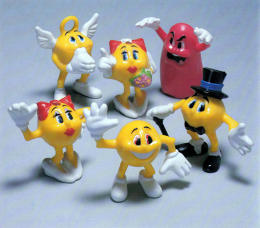
Eventually we settled in a three-way agreement between us, Midway, and Namco, to how the various rights would work over the years that would follow, on characters that would get created and on the use of Pac-Man and Ms. Pac-Man in arcade games, and the use of Ms. Pac-Man elsewhere, etc. All of that was pretty carefully spelled out for the ’80s.
Almost 20 years later, Ms. Pac-Man saw a revival that wasn’t spelled out in the original agreements. In 2000, Namco of America released an arcade machine called ‘Ms. Pac-Man/Galaga-Class of 1981’ that combined the firm’s two all-time most popular arcade titles in one machine, and it represented the second release of Ms. Pac-Man in the arcade. The only problem was that they had not consulted GCC about it.
When GCC veterans heard about the new machine, Macrae and others went knocking on Namco’s door to see what was up. The result shocked them.
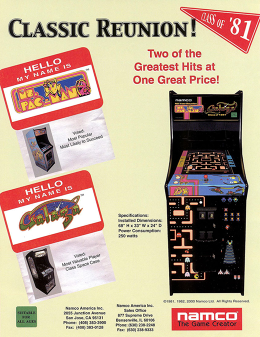
Macrae: They had not even heard of who we were, and did not have any idea that we were the creators of Ms. Pac-Man.
Golson: When we were talking with the folks at Namco, we said, ‘Look, hey guys, we designed this. This little outfit in Massachusetts.’ They were like, ‘What? What are you talking about?’
Macrae: I think this was totally honest because both Nakajima and Nakamura, the two Namco executives we had negotiated with, had passed away. [Class of 1981] was a machine developed by Namco of America. We got the old contract, faxed it out to them, and started our discussions.
After an initial period of confusion, Namco of America and the former shareholders of GCC entered into arbitration that lasted between 2002 and 2007. After a first round over the new Namco arcade cabinet, a second round of arbitration during the period covered the emergence of Ms. Pac-Man onto platforms not envisioned in the 1980s, such as iPods, cell phones, and plug-and-play game consoles. The two firms reached a new agreement whose terms are still confidential.
Macrae: When [Namco of America] decided to put the new game out, I don’t think they had ever known that Ms. Pac-Man was not their creation. We’d never made much noise back in the ’80s that we had created it. I don’t think we’ve ever demanded credit, so I don’t think we’ve really cared. Fame was never what we were after, so that was fine.
Horowitz: I think we’ve all been pretty much low-key about this thing. At some point, people found out about it, and there was some word of us on the internet. We’re all engineers, right? So we’re pretty quiet guys anyway. None of us have been going around bragging that we did Ms. Pac-Man, but it was our friends that would.
Golson: As for getting credit, getting paid was the first step. The thought was, well, eventually somebody will write the big history of video games and then we can talk about how it all came out.
Horowitz: Doug and Kevin have been very nice. When I first signed up, I wasn’t getting a salary, but Doug said that the developers would get 10% of the profits from anything they did. To their credit, when this latest arbitration thing happened, even though we didn’t do much except answer some emails, they held to the same 10%. They didn’t owe us that, but they’re nice guys.
To this day, Namco does not publicly acknowledge that Ms. Pac-Man was created outside of Japan, and Toru Iwatani, the creator of Pac-Man, declines to comment on the very popular American-made spin-off of his game. I have tried to contact Iwatani about this issue twice since 2011, and I have received no response.
Golson: At some point I’d love to sit down with Toru Iwatani and say, ‘Hey, what do you think of us?’
Yeah, I suspect they were a little bit annoyed—probably not so much that they were not responsible for it—but I think that they were very proud of Pac-Man, which they should be. Pac-Man’s a wonderful game.
I think the fact that Ms. Pac-Man showed flaws in their game, that their game could be improved a little bit, might be annoying to them. Maybe they have those feelings. I don’t think that’s very fair to themselves, though.
Horowitz: Typically, there’s a lot of innovation that happens in America and then Japan will take that innovation and refine it a little bit and sell it back to us, so I think we sort of turned the tables on them.
The gameplay of Pac-Man is awesome. There are a lot of games that, like Tetris, are incredibly simple, but they’re really compelling to play. They came out with this great idea, and we fixed those flaws and made a better game.
Golson: Frankly, I’m sure that there are other games under the Namco brand that were designed by third parties, and they do not talk about that either—and rightly so. You contract out for somebody to do some work for you, and whether your acknowledge them or not, it’s up to you. Our attitude was as long as we get paid, we don’t care.
Macrae: It has brought in tremendous amounts of revenue for Namco. They made as much on every Ms. Pac-Man that shipped in America as they did on Pac-Man. If you get down to the profits behind it, they don’t care in the least.
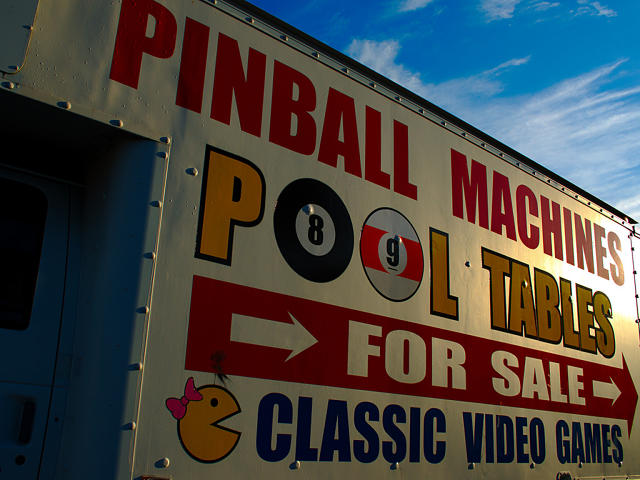
The Legacy
Thirty-five years after its release, Ms. Pac-Man remains both iconic and addictively fun to play. It even makes the news from time to time, as it did in January when computer scientists taught an AI to play the game better than any computer before it, achieving a record-breaking high score of 43,720.
After a brief but successful run in the video game industry, General Computer pivoted to other technologies, creating the first internal hard drive for the Macintosh and a pioneering set-top box for TV Guide before settling down in the laser printer market. Despite decades of work on dozens of products since then, Ms. Pac-man remains a satisfying high-water mark in the lives of the engineers who brought her to life.
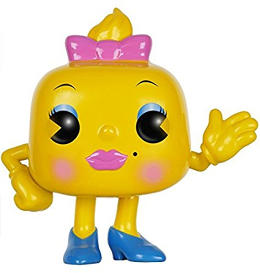
Horowitz: How has it changed my life? It introduced me to a bunch of smart guys and from a career point of view. We made a bunch of money, and it was great. I bought a house basically from the proceeds of Ms. Pac-Man that I still live in.
In terms of Ms. Pac-Man itself, until recently, it really wasn’t a active part of my life. It was something we did in less than a year, and it was fun, but I didn’t walk around with a sign saying ‘I made Ms. Pac-Man.’
Golson: It’s been a real trip, I’ll tell you. It’s the most popular arcade video game ever in the U.S., and to be able to point to that and say I was one of the designers is a real feeling of accomplishment. It certainly turns people’s heads when you tell them and they want to hear the story. On a personal level it affected me because it was financially a big thing.
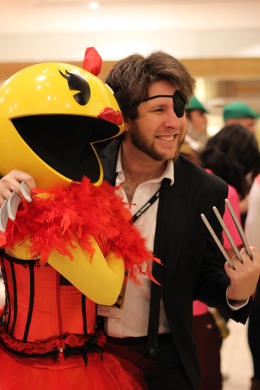
Horowitz: I was 24 when Ms. Pac-Man was released. I have four daughters, and my two oldest are older than I was when I did Ms. Pac-Man. So they sometimes moan, ‘Dad, I’m 25 years old and I haven’t created the most popular video game of all time, I’m a failure.’
Macrae: I still have a Ms. Pac-Man machine in my basement. I was never amazingly good at it, but my wife’s best friend growing up played Ms. Pac-Man a lot, and she got so good at it that she decided to start playing it with her toes. She can beat me while I’m playing with my hands.
Horowitz: They’re all over the place. Usually you see them if you’re driving on the Mass Turnpike that runs through Massachusetts. At all their rest stops, there are all these gas stations, and they all seem to have the combo Ms. Pac-Man and Galaga game.
It was a little short thing in my life that happened: It was wonderful, and I have nothing but great memories of that. It was the only cultural phenomenon I’ve ever worked on.
Fast Company , Read Full Story
(113)

